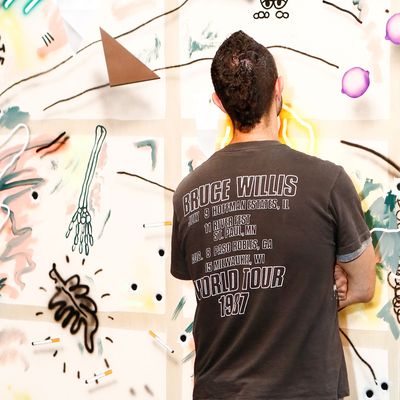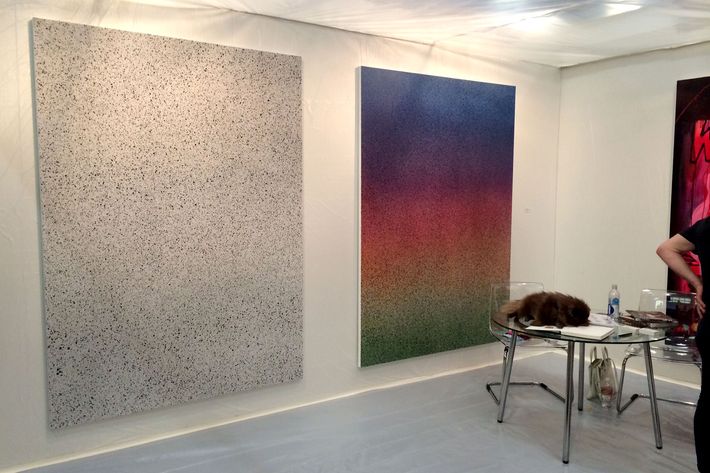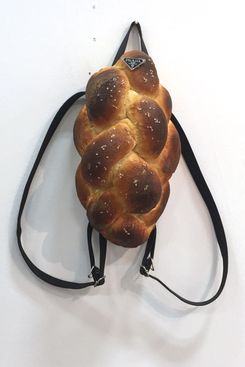
NADA New York offers an alternative to chic, sleek Frieze New York. As befitting the two different fairs, we offer two evaluations of the work on offer at NADA below, from SEENÔÇÖs two staff writers.
Kyle: Zombie Formalism, Undead
Located inside Basketball City, that warehouselike gymnasium on the water off the brick towers of the Lower East Side, the fair has something of the atmosphere of a middle-school dance, what with the scoreboards folded up toward the ceiling. Also like a middle-school dance, NADA is filled with participants who have a lot in common and want to get along with each other, so they tend to follow a herd mentality.
The fair is smaller, more accessible, and more uniform than Frieze. What the kids are wearing this spring seems to be a mutant variant on ÔÇ£zombie formalism,ÔÇØ which is more undead than ever. Coined in April of last year by critic Walter Robinson and echoed by our own Jerry Saltz, the term refers to a loose, gormless, novelty-seeking form of abstract painting that hedges every bet at relevance. At NADA, the zombies have moved off the canvas and onto every surface imaginable.
ThereÔÇÖs a sculpture with domestic metal objects rotating around a magnetic pole driven through an Ikea shelving unit at 247365 gallery, immaculately generic. Squishy blobs proliferate in vacuum-sealed paintings and bean-bag podiums. The Hole is showing wall-size spray-painted canvases of lazy color fields by Zane Lewis on top of walls covered in the same plastic tarp that they would have presumably been sprayed on top of. An elegant wall-mounted ceramic version of zombie formalism could be found with Brie RuaisÔÇÖs work at Nicole Klagsbrun, offered at $22,000.
Painting itself embraced either a strategy of adaptive collage or accepted an inability to choose a path among the myriad offered by art history. Abstraction? Figuration? Josh ReamesÔÇÖs gently trompe lÔÇÖoeil canvases at Johannes Vogt ($9,500) swiped right on all of it, presenting isolated elements of gestural abstraction floating with symbolic icons ÔÇö cigarettes ÔÇö in a vacuous empty pictorial space.
Elsewhere, painter Ted Gahl molded canvases over paint-stirring sticks in geometric patterns ($6,500) alongside larger works that manage to bring back to life the good parts of modernist abstraction the way Mad Men has revived the ÔÇÿ60s ($14,000). JapanÔÇÖs manic pixie dream girl, Misaki Kawai, has packed Eric Firestone GalleryÔÇÖs booth with acid-colored, impasto cartoons and custom furniture ÔÇö might you be decorating a kidsÔÇÖ room?
On the opposite side of Zombie Formalism, heating up the basketball court, were Jansson StegnerÔÇÖs highly figurative softcore cheerleader portraits at BrusselsÔÇÖs Sorry WeÔÇÖre Closed gallery. Like a Waspier version of John Currin (if thatÔÇÖs even possible), they demonstrated that the human body still has more than enough life left in it to sustain creative interest. In fact, the human body was much in sight on the deck of Basketball City, the only area in the fair from which the wide expanse of the East River was visible. As the sun set, there seemed to be more people crowding the picnic tables and jostling one another for free guacamole than inspecting the work on the temporary walls.
Nate: The Un-Instagrammable Fair
Sure, there might have been enough of the kind of formless abstraction decried on this site and others, but the one thing IÔÇÖve noticed is that they donÔÇÖt play too well on Instagram. And I donÔÇÖt mean to belabor a point here ÔÇö I talked about the Instagramming at Frieze, and how it related to those Richard Prince works at the Gagosian Gallery booth ÔÇö but when a small fair of generally inexpensive works generates thousands upon thousands of pictures tagged #nadany, it should be involved in the conversation.
You canÔÇÖt asses the quality of a work based on how many ÔÇ£likesÔÇØ it getsÔÇöperhaps you should do the opposite, really. But the truth is, those works of ÔÇ£zombie formalismÔÇØ that do indeed take up a decent amount of real estate down at Basketball City, well, theyÔÇÖre not exactly setting the internet on fire. Our good friend @Freeze_de (who is, sigh, an anonymous satirical Instagrammer, but bear with me) might have summed it up best in this post: ÔÇ£What an exciting time to be alive.ÔÇØ Nothing against the work necessarily, but the kids arenÔÇÖt gonna double-tap a Ted Gahl.
So, what exactly did get snapped and posted the most? Well, itÔÇÖs pretty hard to ignore the giant Elizabeth Jaeger sculpture Maybe We Die So the Love DoesnÔÇÖt Have To, which is a sculpture of a man and a woman mid-coitus and looking perfectly smiley because of it. ThereÔÇÖs a captivating felt work by Jonathan Baldock of guy with a Fu Manchu ÔÇö really big Fu Manchu, really awesome Fu Manchu. We have Chloe Wise giving the people what they want with her AinÔÇÖt No Challah Back (Pack) Girl ÔÇö yes, itÔÇÖs a backpack thatÔÇÖs seemingly fashioned from a Challah loaf ÔÇö and a newer sculpture of a stack of pancakes.
Works that what I would have Instagrammed if I used the thing more often probably would have been works by Sam Lipp, Chloe Siebert, and Puppies Puppies in the Courtney Blades booth ÔÇö especially one of LippÔÇÖs Michael Jackson paintings, which were somehow both skin-crawl creepy and warm, almost loving. Perhaps thereÔÇÖs exploring to do in what seems like an exciting gallery scene in Chicago, where Courtney Blades opened five years ago. And Betty TompkinsÔÇÖs Fuck Painting #10, at Louis B. James, is marvelously explicit, showing how babies are made in all its beauty. Come to think of it, that would probably get me banned if I posted it.
But I would be remiss to leave out what was probably the most photographed work of them all: the ÔÇ£taco toastÔÇØ ÔÇö a much-improved spin on the normal art-fair Champagne toast ÔÇö on the sun-washed riverside dock behind the fair, where everyone got free food from Caf├® El Presidente and beer and cocktails to go with it. There were some bright spots at NADA, but itÔÇÖs hard to compete with free tacos.



